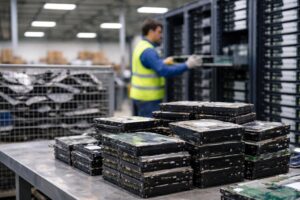The global logistics industry has an immediate need to cut emissions. Greenhouse gas emissions are mostly a result of distribution and transportation of products. Nevertheless, this obstacle also offers a chance for improvement. In this shift, electrifying logistics has come to be seen as a crucial tactic. It guarantees a significant global reduction in supply chains’ carbon impact. Moreover, the trend towards electric cars is picking up speed quickly. From long-haul trucks to last-mile delivery vehicles, everything is impacted by this modification.
This transformation goes beyond simply replacing engines. It necessitates a thorough reconsideration of operations and infrastructure. Furthermore, businesses have to weigh short-term expenses against long-term sustainability objectives. They also have to make sure that regulations are followed. Moreover, they must meet evolving stakeholder expectations. Electrifying logistics addresses environmental concerns and offers operational efficiencies. Furthermore, it provides new competitive advantages in an eco-conscious market. In this article, we will look deeply into electrifying logistics, its strategies, challenges, and more.
The Drive Towards Zero-Emission Logistics
Several factors are pushing the industry towards electrification or electrifying logistics. So, let’s look at these factors in detail:
Climate Change Imperatives
Transportation is a major industry contributing to high emissions. It is thus a top priority for decarbonization initiatives. Logistics operations face increasing pressure to reduce their environmental impact. This is because freight transport causes about 8% of global CO2 emissions with road freight alone contributing approximately 5%. Thus, in the absence of action, this might rise to 8–10% by 2050.
Electrifying logistics is a realistic way to significantly cut these emissions. There are no emissions from the exhaust of electric cars (EVs). Moreover, they have a negligible carbon impact while running on renewable energy. Additionally, EVs have fewer lifespan emissions than conventional cars, even with the existing energy mix. They are therefore a desirable choice for businesses trying to lower their carbon footprint.
Regulatory Landscape
Governments worldwide are implementing stringent regulations. The goal is to speed up the logistics industry’s move to electrified transportation. Countries worldwide are cracking down on gas-guzzling engines. Consider the EU as an example. By 2035, the sale of new petrol and diesel vehicles will be prohibited by them. Indeed, it’s a significant shift. The goal? Cut pollution and embrace cleaner transport options. This shift is happening fast, and it’s reshaping the auto industry as we know it. Similar initiatives are being considered for commercial vehicles.
California in the US mandates that by 2045, all new trucks have zero emissions. Governments provide incentives to support this transition. These include tax benefits for zero-emission fleets and subsidies for buying electric vehicles. They also fund the building of charging stations. Commercial electric cars are significantly subsidized by the US Inflation Reduction Act of 2022. For qualified cars, it can reimburse up to 30% of the purchase price.
Market Pressures and Opportunities
Electrifying logistics is also being driven by market pressures. Furthermore, consumers are beginning to evaluate sustainability more heavily when making selections. According to recent surveys, 32% of customers are very driven to live more environmentally responsible lives. This involves taking into account how product distribution may affect the environment. Therefore, companies are adopting greener logistical strategies to gain a competitive edge.
Furthermore, investors are placing greater emphasis on ESG factors. So, a company can significantly improve its environmental performance. This is by electrifying its logistical processes. This can result in enhanced stock performance and easier access to financing. Major logistics companies have seen positive market reactions to ambitious electrification plans. This reflects strong investor support for these initiatives.
Cost Considerations
Electric cars and infrastructure may initially cost more than more conventional options. But the financial advantages in the long run are becoming more and more obvious. Due to their lower fuel costs, electric cars usually have lower operational costs. They also need less upkeep. Advances in battery technology will reduce the overall cost of owning electric logistics vehicles. In the long term, they could even prove to be more economical than conventional automobiles.
Furthermore, as carbon price expands, zero-emission logistics ought to become more economical. So, early transitioning businesses might have a competitive advantage. They can avoid potential carbon taxes and benefit from various incentives for clean technology adoption. So, this is one of the most powerful ways when it comes to how can emissions from logistics be reduced.
Zero-Emission Supply Chains: Technological Advancements Enabling Electrification
Rapid technological innovation is making electric logistics increasingly viable. This section examines key developments facilitating the transition.
Electric Vehicle Technology
Innovations in electric vehicles are solving many of the early issues with it. The technology around batteries has advanced significantly in recent years. Furthermore, lithium-ion batteries are becoming increasingly superior. This is particularly about storing more energy in smaller containers. So, this means that electric cars will have more range. Moreover, fast-charging technologies are developing quickly at the same time. So, large commercial vehicle batteries can currently charge up to 80% capacity in less than an hour using some technologies.
Additionally, electric commercial vehicle sales are rising rapidly. It provides answers for a range of logistical requirements. Among the choices for last-mile delivery are tiny electric vans and heavy-duty electric semi-trucks. Furthermore, both known manufacturers and startups are developing several electric vehicle options for logistics.
Charging Infrastructure
The widespread adoption of electric logistics depends on a strong infrastructure for charging. Furthermore, major transport routes are seeing the rollout of fast-charging networks. This addresses range anxiety for long-haul electric logistics. For instance, the European Union mandates high-power charging stations every 60 km along major highways by 2025. In the United States, similar networks are being developed through national initiatives.
For many logistics operations, depot charging remains the primary method. Advancements in smart charging systems allow for optimized charging schedules. These balance vehicle needs with electricity costs and grid capacity. Some systems even integrate on-site renewable energy generation and storage.
Energy Management Systems
Sophisticated energy management systems are becoming integral to electric logistics operations. These systems optimize the charging process. They balance factors such as electricity prices, grid capacity, and vehicle schedules. Advanced algorithms can predict energy needs based on route planning and historical data. This ensures vehicles are charged optimally for their intended use.
Furthermore, vehicle-to-grid (V2G) technology is beginning to revolutionize the market. This enables electric cars to recharge the grid as necessary. It potentially creates new revenue streams for logistics companies. Additionally, it contributes to grid stability.
Alternative Zero-Emission Technologies
Electric cars are setting standards when it comes to environment-friendly transportation. However, many more technologies are coming up. For instance hydrogen fuel cell cars. They are particularly great for heavy-duty or long distances. They provide longer range and faster refueling times. Some logistics companies are exploring a mix of battery-electric and hydrogen fuel cell vehicles. This optimizes their zero-emission fleets for different operational needs.
Additionally, research into alternative battery chemistries continues. Faster charging times and an even higher energy density are provided by solid-state batteries. These technical advancements allow the logistics sector to adopt emission-free cars faster.
Implementation Strategies for Zero-Emission Logistics
Making the switch to zero-emission logistics or electrifying logistics involves thoughtful preparation and calculated execution. Important tactics for businesses starting this journey are outlined in this section.
Approaching Fleet Electrification in Phases
Many businesses are electrifying their buildings gradually. This allows them to learn and adapt as they transition their fleets. Often, this begins with last-mile delivery operations. These are well-suited to current electric vehicle capabilities. By 2030, businesses like FedEx and UPS want to buy only electric vehicles for last-mile deliveries.
Businesses are electrifying longer routes as infrastructure for charging increases and technology advances. This often involves piloting electric trucks on specific routes before wider deployment. For example, Walmart is testing electric Class 8 trucks for regional haul routes. They plan to expand based on the success of these pilots.
Infrastructure Planning and Development
Effective electrification requires careful planning and investments in infrastructure for charging. Businesses must do a thorough assessment of their infrastructure requirements. This includes evaluating power capacity at depots and identifying optimal locations for charging stations. Many logistics companies are partnering with utilities and charging infrastructure providers. These partnerships help develop comprehensive electrification plans.
Setting up charging stations for electric vehicles isn’t something one group can tackle alone. It often takes teamwork between government agencies and businesses. By joining forces, they can split the costs and share the potential risks involved in creating a widespread charging network. They also ensure charging networks meet both commercial and public needs.
Employee Training and Change Management
The transition to electric logistics requires significant changes in operational practices. Companies must invest in comprehensive training programs for staff. This includes training on the operation and maintenance of electric vehicles. New safety protocols related to high-voltage systems must also be taught.
Change management strategies are crucial for smooth adoption. Clear communication of the rationale behind the transition is essential. Building support involves addressing worries and misunderstandings. Employee enthusiasm and dedication to the zero-emission future are also increased. This is when they are included in the planning process.
Data-Informed Decision Making
Optimizing the transition requires utilizing analytics and data. Advanced telematics systems provide valuable insights into vehicle performance and energy consumption. This data can inform route optimization and charging schedules. It also helps with maintenance planning, maximizing the benefits of electric fleets.
Businesses can anticipate future requirements and issues with the use of predictive analytics. So, proactive planning and investment are made possible by this. Businesses can ensure a smooth and profitable shift to zero emissions. This is accomplished by putting a data-driven plan into practice.
Electrifying Logistics: Overcoming Transitional Challenges
Making the switch to zero-emission logistics offers many advantages. However, it also presents some difficulties. So, let’s take a look at them ahead:
Range and Payload Limitations
Electric vehicle technology still needs to be improved in range and payload capacity. This is especially valid for heavy-duty and long-distance applications. Companies need to plan routes and loads to accommodate these limitations carefully. This may involve redesigning logistics networks or increasing trip frequency. Using a mix of zero-emission technologies can also help meet different operational needs.
Initial Capital Costs
The higher upfront costs of electric vehicles and infrastructure can be a significant barrier. This is especially challenging for smaller logistics companies. To address this, companies are exploring various financing options. These include leasing arrangements and partnerships with vehicle manufacturers. Government incentives and grants also play a crucial role in offsetting initial costs.
Grid Capacity and Renewable Energy Integration
As more logistics fleets electrify, the increased demand for electricity could strain existing grid infrastructure. Upgrading grid capacity is essential to ensure a smooth transition. Integrating renewable energy sources is also crucial for truly reducing emissions. Companies are working closely with utilities to plan for increased power needs. Many are exploring on-site renewable energy generation to supplement grid power.
Supply Chain Readiness
Modifications to the larger supply chain ecosystem are necessary for the shift to zero-emission logistics. So, partners, clients, and suppliers must adjust to the changing operating needs. This may involve adjusting delivery schedules or modifying loading dock infrastructure. Building a supportive ecosystem is crucial for the successful implementation of zero-emission logistics strategies.
Electrifying Logistics: Future Outlook and Emerging Trends
The field of zero-emission logistics is changing quickly. This change fuels the future of the industry with several developments. So, let’s see what is the future of electric vehicles in logistics:
Advancements in Battery Technology
Ongoing research will address numerous existing constraints in battery technology. Furthermore, solid-state batteries can charge more quickly and with a higher energy density. These emerging technologies have the potential to significantly improve the capabilities of electric logistics vehicles. As a result, they could be appropriate for even more uses.
Integration of Autonomous and Electric Technologies
The integration of autonomous and electric vehicle technology has the potential to completely transform logistical processes. Furthermore, self-driving electric trucks can optimize routes and charging schedules while operating around the clock. Significant efficiency benefits and additional reduction of environmental impact could result from this combination.
Policy and Incentive Evolution
As the transition progresses, policies and incentives are likely to evolve. We could witness larger carbon pricing schemes and stricter emissions controls. Moreover, tailored incentives may appear to solve certain issues facing the logistics industry. So, businesses will be more likely to prosper if they keep up with policy changes.
Circular Economy in Electric Logistics
Circular economy principles are increasingly being applied to electric vehicle lifecycle management. This includes designing vehicles for easier recycling and refurbishment. Developing second-life applications for used EV batteries is another focus area. Creating closed-loop zero-emission supply chains for critical materials is also gaining importance. These practices will become crucial for maximizing sustainability as electrifying logistics grows.
To Sum Up
The logistics business is undergoing a significant transformation with the shift to supply chains with zero emissions. It is motivated by the pressing need to handle both changing consumer expectations and climate change. Here’s where electrifying logistics presents a bright future. It is supported by rapid technological advancements. Moreover, growing regulatory and market incentives further encourage this transition.
This change is not without difficulties, though. It calls for thorough preparation, a substantial financial commitment, and an openness to innovation. Nevertheless, the logistics industry appears to have a promising future. Moreover, emerging technologies and practices are poised to overcome current limitations.
For professionals looking to stay at the forefront of this transition, an opportunity awaits. The upcoming Net-Zero Supply Chain Summit in Amsterdam, Netherlands on September 12-13, 2024, offers valuable insights. This event brings together industry leaders, innovators, and experts. They will discuss the latest developments and share best practices on sustainable supply chains. There will also be a dedicated networking session. So, this summit helps you stay ahead in a changing field. Register today!




